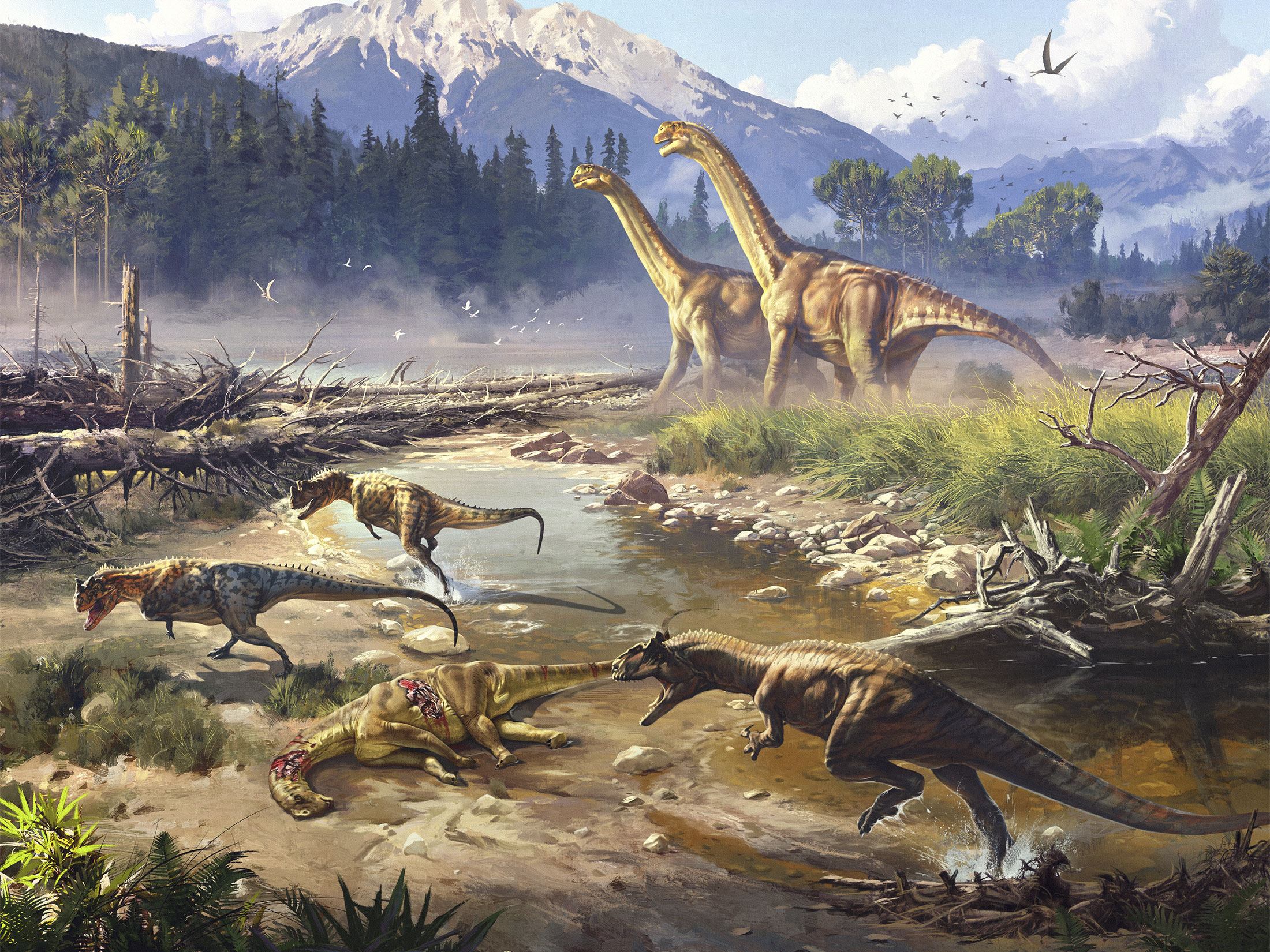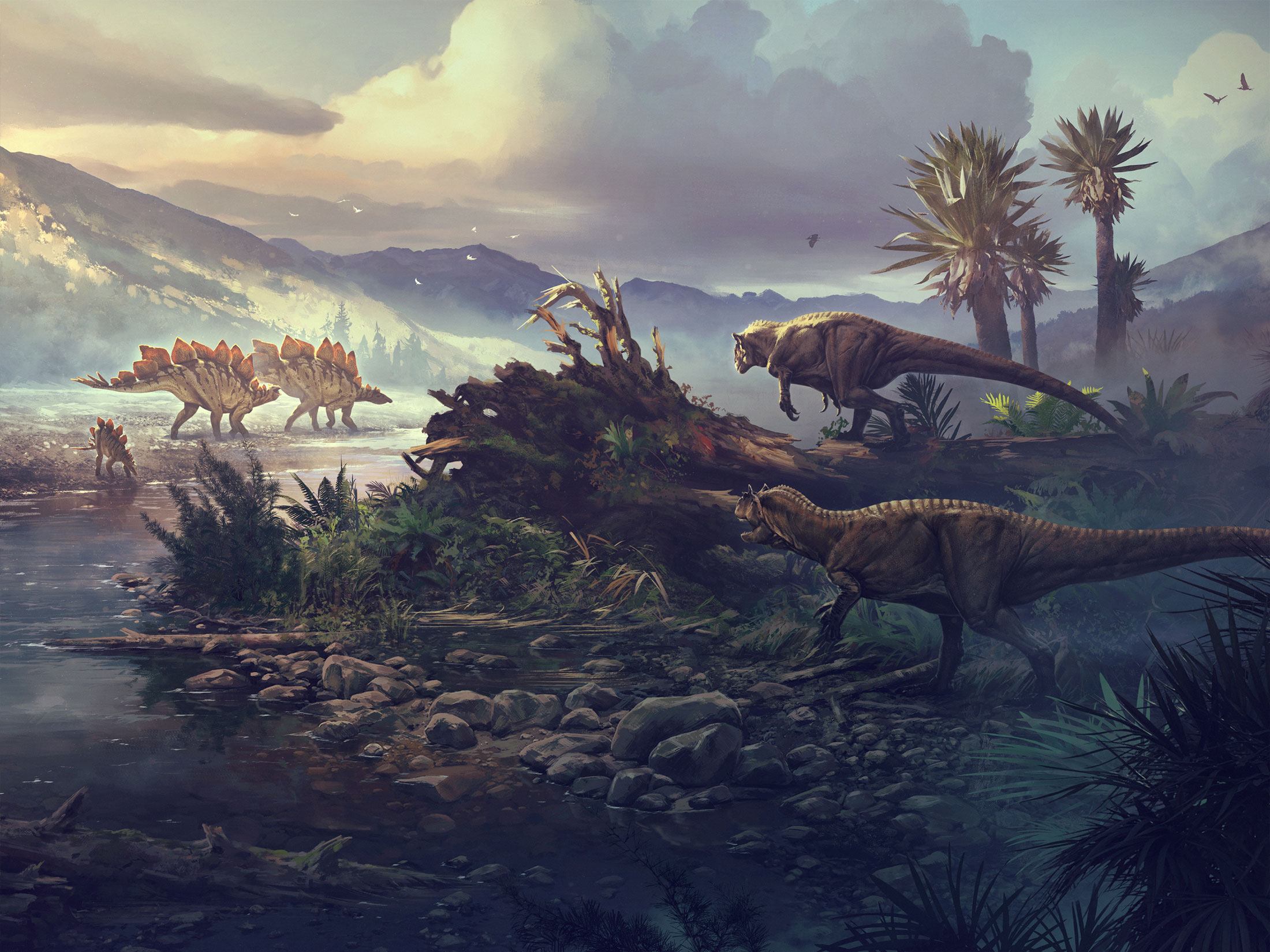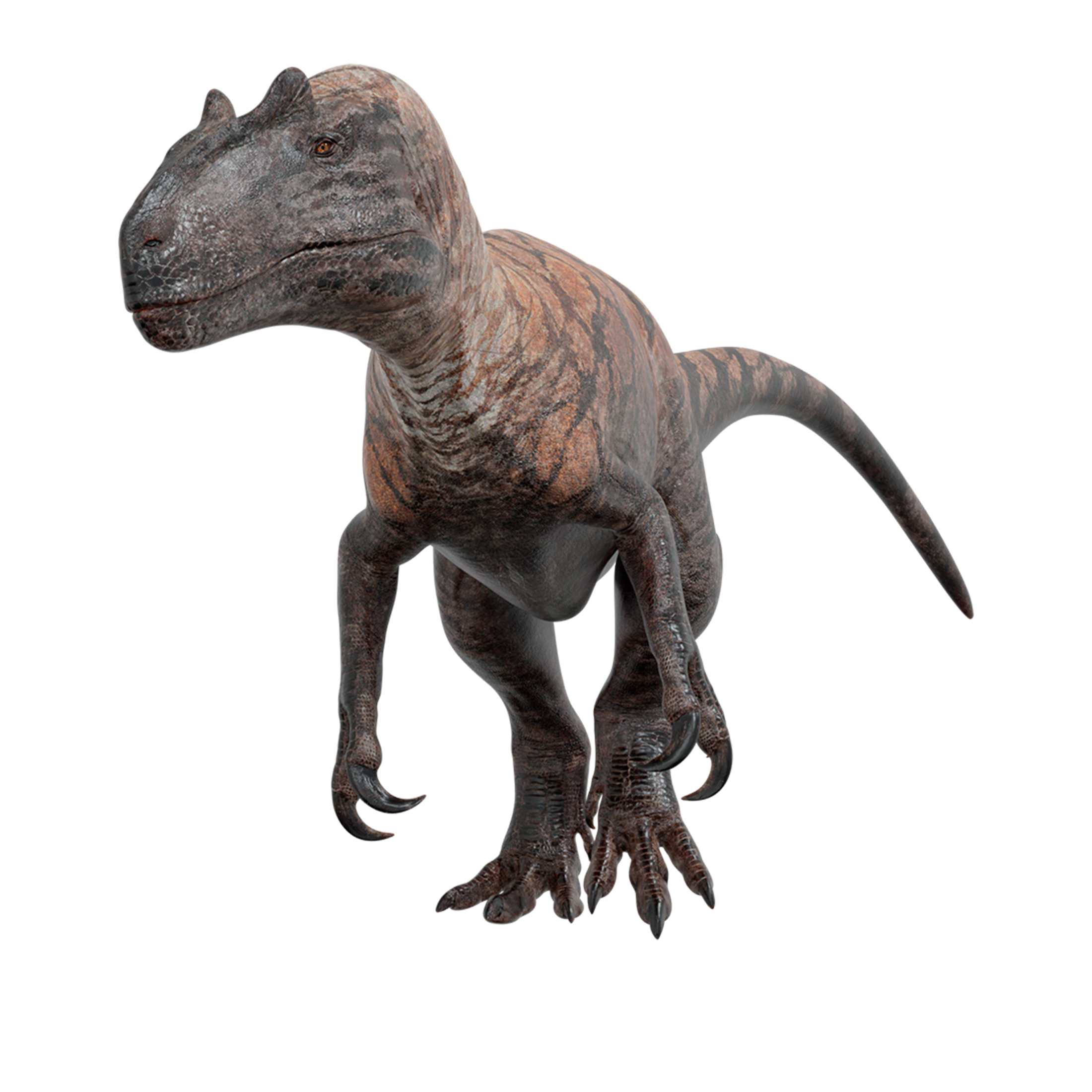The Lion of the Jurassic
Allosaurus was one of the top predators of Late Jurassic North America, and the most common, making it one of the best-studied theropod dinosaurs. Its abundant fossils have provided a wealth of information and valuable insights into various aspects of its biology.
Overview
Allosaurus fragilis was one of the most successful and widespread theropods of Late Jurassic North America, as well as one of the largest and most fearsome, earning it the nickname “Lion of the Jurassic”. Like lions, Allosaurus fragilis was an opportunistic predator that hunted on the open plains. Its prey would have included whatever it could catch including ornithischians like Stegosaurus, and sauropods such as Apatosaurus. First named in 1877, Allosaurus fragilis has since become known from at least 60 individuals discovered throughout the American west, making it one of the most well-known and well-studied dinosaurs in history.
Discovery
Allosaurus fragilis was discovered in the midst of the Bone Wars, a period of intense competition and animosity between archrival paleontologists Edward Drinker Cope and Othniel Charles Marsh. At first, some fragmentary Allosaurus remains were referred to another previously known genus, the European megalosaur Poekilopleuron. This material was later given the name Antrodemus by paleontologist Joseph Leidy in 1870. Seven years later, Marsh would name Allosaurus fragilis based on only slightly more complete material. Allosaurus is a Greek name coming from “allos” meaning “different” or “strange” and “sauros” meaning “lizard” or “reptile”, thus Allosaurus is the “different lizard”, so called because its vertebrae were unique among known dinosaurs at the time. The species name “fragilis” is Latin and means “fragile”, also in reference to the vertebrae, which were lightly built. In 1878 and 1879, more Allosaurus material would be named under different genera, including Apatodon, Creosaurus, and Labrosaurus, named by Marsh, and an especially large but fragmentary individual named Epanterias by Cope, though he actually thought it was a sauropod at the time.
It soon became clear that many of these names were redundant, and in 1920 Charles Gillmore decided that Antrodemus should be the preferred name, seeing as it was the first name to be assigned, which normally under nomenclature rules makes it the official name. However, in 1960, extensive work, led by James Henry Madsen, began on the Cleveland-Lloyd Quarry in Utah, which produced at least 46 specimens of Allosaurus fragilis. And that was the name under which Madsen published them, arguing that the type material for Antrodemus was too undiagnostic to be a valid taxon, thus cementing Allosaurus fragilis as the preferred name for the species. Since then, even more Allosaurus fragilis specimens have been discovered, resulting in a total of at least 60 known individuals. Two other species of Allosaurus are currently recognized: Allosaurus europaeus from Portugal, and Allosaurus jimmadseni from western North America and named in honor of James “Jim” Madsen.
Physical Description
Allosaurus fragilis had a typical large theropod body plan. It was bipedal, with a large skull, a relatively short neck (nine cervical vertebrae) and a long tail (~45 caudal vertebrae) that would have been held horizontally, acting to counterbalance the front of the animal. Allosaurus had pneumatized vertebrae like those of birds and would have had an avian-style respiratory system, most likely complete with bird-like air-sacs that would have occupied the vertebral pneumatic cavities. On average, Allosaurus fragilis grew to about 28 ft long, but the largest confirmed individual was 33 ft, and there are reports of some growing even larger. Allosaurus could have weighed between 1 and 3 tons, but the average weight based on existing fossils is about 0.75-1 ton.
Like most other theropods, Allosaurus had functionally tridactyl feet, with digits II-IV bearing the animal’s weight, in addition to a reduced digit I, called a dewclaw, which did not touch the ground and probably had little to no use in the adults, but which may have aided in grasping in juveniles. Each toe bore a claw. The arms were comparatively short (though not as reduced as the later carcharodontosaurids or tyrannosaurids), only 35% of the hindlimb length. Nevertheless, the arms were strong and bore three fingers, each tipped with a wicked curved claw which would have aided the predator in grasping prey.
The skull was large, and somewhat laterally compressed giving it only limited depth perception, about a 20° field of binocular vision. The skull, while large was lightly constructed, in part due to the antorbital fenestra between the orbit (eye) and nostril. The primary purpose of this opening in theropods appears to lighten the skull. The lacrimal bones formed hornlets over the eyes, probably used as a sunshade for the eyes and/or for display. The jaws, which could open to a 92° angle, very wide even by theropod standards, were lined with 66-78 short, serrated teeth, which were thicker and more conical toward the front of the mouth (premaxillary teeth are D-shaped in cross-section) and thinner and more blade-like toward the back of the mouth. These teeth, like those of crocodiles, were continually replaced, so teeth that were broken or worn down weren’t a problem for long. On average, Allosaurus may have replaced any given tooth every 104 days, or about every three or four months.
We don’t know what colors Allosaurus may have been, but there is reason to believe that it was covered in scales instead of feathers. While many other theropods are known or suspected to have had feathers, and indeed, feathers may have been ancestral to all dinosaurs, the one or two skin impressions we have from Allosaurus show scales.
Life Cycle and Metabolism
Like all dinosaurs, Allosaurus would have hatched from eggs, though no confirmed Allosaurus eggs have been found in the fossil record. Juvenile Allosaurus were gracile and had proportionally longer legs than the adults. As the animals grew, they became more robust with proportionally shorter legs, which may have allowed for short bursts of speed (probably between 19 and 34 mph), but probably precluded them from moving as fast over long distances. Allosaurus hit its maximum growth rate of about 330 lbs/year around age 15, with growth tapering off and ceasing around 22-28 years of age, similar to other large theropods including T-rex. Like T-rex, Allosaurus may not have lived long past 30 years old.
These growth rates are evidence for a warm-blooded metabolism. Warm blooded animals tend to have finite growth periods, high growth rates, and often shorter lifespans, whereas cold-blooded animals grow throughout their lives, albeit at a slower rate which begins to taper off as they get older, and they tend to live longer. For comparison, crocodiles, which are cold-blooded, grow throughout their life and can live well over up to 70 years, some maybe even reaching 100, while most theropods ceased growth in their 20s and died by the time they reached their early 30s. Having a high metabolism meant that these creatures would have needed to eat a lot and often.
Most warm-blooded animals have fur or feathers, but as mentioned before, Allosaurus appears to have been scaley. While this may seem like a contradiction, it may be explained by its environment. North America in the Late Jurassic had a very warm tropical climate. Big animals in warm climates often reduce or lose their insulation to keep cool. Modern examples include elephants and rhinos which, while being mammals, are mostly hairless. With this in mind, it has been speculated that while adults of large theropods were mostly or entirely covered in scales, babies may have hatched fluffy, as small warm-blooded animals tend to lose more heat and have a harder time regulating their temperature than large animals. As the theropods grew, their surface area would have shrunk relative to their volume, making it easier to regulate their temperature without needing insulation. So, given the warm climate, they lost their feathery down as they grew. That is the theory anyway. No direct evidence for fluffy baby allosaurs or tyrannosaurids has been found, and our understanding of theropod physiology is still limited, leaving much up to speculation.
Behavior and Ecology
Allosaurus fragilis was carnivorous and most likely an active predator. While some have speculated it might be an obligate (full-time) scavenger, this is unlikely due to its size. Obligate scavengers are rare in modern ecosystems and tend to be small. Big animals, especially big warm-blooded animals, need more energy to survive, and it is difficult for bigger animals to find enough food from scavenging alone. Many animals typically thought of as scavengers, including hyaenas, actually get much of their food from hunting. And on the flip side, many predators, including lions, will gladly scavenge when they can. As a carnivore many times the weight of a hyaena or lion, Allosaurus and other theropods were almost certainly opportunistic carnivores, primarily hunting, but scavenging when carrion was available.

Allosaurus is known to have consumed sauropods, including Apatosaurus, based on bite marks on sauropod bones. Bite marks on a Stegosaurus dorsal plate indicate that this species was also at least occasionally targeted by Allosaurus. Even more dramatic evidence for this comes from an Allosaurus with a healed puncture wound on a vertebra from a Stegosaurus’s tail spike (called a thagomizer) indicating a predation attempt where the predator was injured by its intended prey.

The short, serrated teeth would have been excellent at slicing flesh, and Allosaurus may have killed prey by inflicting numerous shallow wounds and letting the animal bleed out, though much uncertainty remains about how exactly they hunted and fed. Some have suggested that Allosaurus may have hunted in packs, though this too is questionable, especially because pack hunting is extraordinarily rare in modern reptiles and birds. If they did gather in groups to hunt or feed, it may not have been truly cooperative. Instead, it may have closer resembled the feeding frenzies of modern Komodo dragons than an organized pack.
Allosaurus was not the only predator in Morrison Formation. They shared their environment, and potential prey, with a few other large theropods including Ceratosaurus, Torvosaurus, and Saurophaganax. Both Torvosaurus and Saurophaganax were both longer and much more massive than Allosaurus, and despite being a top predator itself, in habitats where these giants lived, Allosaurus would have been second fiddle. It is possible that like a bear stealing a kill from a wolf, these larger predators may have sometimes bullied Allosaurus off their kills. However, where these larger predators were absent, Allosaurus would have been the apex predator, and lived up to its nickname as the “lion of the Jurassic”. What’s more, Allosaurus appears to have been much more abundant than the apparently much rarer Torvosaurus and Saurophaganax. Another potential competitor was the slightly smaller Ceratosaurus. However, these appear to have solved this competition issue by occupying slightly different habitats with Allosaurus being more common on the open plains (another similarity to lions which helps justify the nickname), and Ceratosaurus occupying the gallery forests that grew along rivers. Torvosaurus may have also been more closely associated with forests and Saurophaganax may have been restricted to the more arid southern Morrison of Oklahoma. Thus, like modern lions, Allosaurus was probably king of the savanna.
Popular Culture
As one of the earliest discovered and best known big theropods, Allosaurus is well known and beloved by scientists and the public, and though overshadowed since the discovery of T-rex, it has nevertheless found its way into numerous instances of pop culture. It was the apex predator in Arthur Conan Doyle’s The Lost World and its movie adaptations. It may have been the basis for the main theropods in the King Kong movies, though it is debated if they are based more on Allosaurus or T-rex. And it has starred in several documentaries, including the beloved Walking with Dinosaurs series, which is where the title of “Lion of the Jurassic” originated. More recently, Allosaurus has been featured semi-prominently in the Jurassic World movies and their associated spin-off games. Beyond movies and media, Allosaurus fragilis also bears the distinction of being the state vertebrate fossil of Utah, chosen because of the numerous specimens found in Utah (mostly at the Cleveland-Lloyd Quarry).
Allosaurus has stood the test of time as both a scientific and a cultural icon, even if T-rex has hogged most of the spotlight. As more people, whether they be fans of movies or actual scientists or both, become interested in dinosaurs, it is safe to say that “The Lion of the Jurassic” is in no danger of going extinct in our collective cultural consciousness. It is more alive now in the minds of inquisitive humans than it ever has been since their disappearance from the plains of North America 145 million years ago.
Allosaurus FAQ
Allosaurus size / How big was an Allosaurus?
See height, weight, and length.
Allosaurus height / How tall was Allosaurus?
Allosaurus was probably 2.8 meters (9.2 ft) tall.
Allosaurus weight / How much did an Allosaurus weigh?
Allosaurus probably weighed about 1.7-2.7 tonnes (1.9-3 US tons)
How long was Allosaurus?
Allosaurus fragilis was 8.5-9.7 meters (28-32 ft) long.
What did Allosaurus eat?
Allosaurus ate meat, specifically other dinosaurs, including sauropods like Apatosaurus.
What is Allosaurus’s closest living relative?
Like all dinosaurs, the closest relatives of Allosaurus are the only surviving lineage of dinosaurs today, the birds. Crocodilians, while not dinosaurs themselves, are also more distant cousins of dinosaurs.
Allosaurus family members / Allosaurus family / What kind of dinosaur was Allosaurus?
Allosaurus was a theropod (two-legged, mainly carnivorous dinosaurs) in the clade Allosauroidea and the family Allosauridae.
How many teeth did Allosaurus have?
Allosaurus had 66-78 teeth!
Where did Allosaurus live? / Where was Allosaurus found?
Allosaurus fragilis lived in western North America and has been found in Colorado, Montana, New Mexico, Oklahoma, South Dakota, Utah, Wyoming.
When did Allosaurus live?
Allosaurus lived about 155-145 million years ago at the end of the Jurassic Period.
What does Allosaurus mean? / Allosaurus name meaning
Allosaurus means “Different Lizard”.

